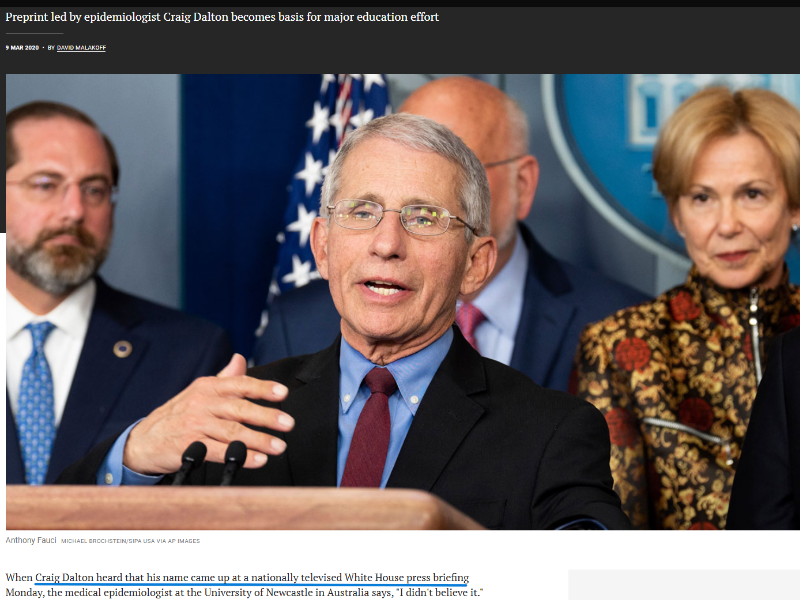Tracking flu outbreaks to improve public health
How a simple idea inspired the creation of the world’s largest crowd-sourced public health surveillance system.
Every year in Australia, influenza leads to more than 300,000 visits to our GPs, over 18,000 hospitalisations and roughly 3,500 deaths.1
Dr Craig Dalton – a public health clinician, researcher and lecturer with the University of Newcastle – developed the award-winning FluTracking program which collects data from members of the public during Australia’s annual flu season (usually May to October) and other key times of the year.
The data helps health officials determine the onset of influenza and better understand the burden and severity of the disease.
Since its creation in 2006, FluTracking has expanded to monitor the occurrence of the RSV virus, COVID-19 and other extreme events. It’s also broadened its surveillance network to include New Zealand, Fiji, Hong Kong and Argentina.
As of June 2025, the team has collected over 33 million surveys from more than 320,000 volunteer 'flu trackers', making FluTracking the largest crowd-sourced public health surveillance system in the world.
From a simple vision to a life-saving platform
FluTracking was inspired by a 2005 telephone survey of 1,500 people in Sweden to establish a snapshot of flu rates in that country. Intrigued by the concept, Dr Dalton set out to find a way to collect vital public health data from more people, more often and in a scalable way.
FluTracking uses a weekly web-based survey to collect data about symptoms, time taken off work, vaccination status, laboratory results and more. Upon joining, participants receive a weekly email with a report on respiratory virus activity and a map of viral hotspots.
Data is posted on the FluTracking website and shared with public health departments so emergency departments and public health units can monitor disease levels in their local region. Insights are also shared with national health agencies in participating countries to help them monitor severity, transmission and testing at a national level.
When Coronavirus emerged in Australia in early 2020, Dr Dalton’s team deployed FluTracking surveys four months early to monitor COVID-19. The team saw a spike in participation as people rallied to help contain the virus, with nearly 110,000 Australians signing up to be part of the citizen surveillance program during the peak of the pandemic.
The FluTracking team has since adapted the platform to rapidly assess community health impacts after extreme events, delivering benefits to public health officials and affected communities.
Impact
- FluTracking started in the NSW Hunter region with 400 participants. It’s grown to collect over 33 million surveys from more than 320,000 volunteer 'flu trackers' across Australia, New Zealand, Fiji, Hong Kong and Argentina.
- Dr Dalton’s expertise influenced international public health policy during the global COVID pandemic. In March 2020, health authorities in the United States issued guidelines for American homes, schools and workplaces based on a paper Dr Dalton had written with colleagues from Sydney University and Australian National University. (Science, March 2020)
- To help monitor the spread of COVID-19 in Australia, the country’s Deputy Chief Medical Officer used his media briefings to encourage Australians to join FluTracking. (Canberra Times, April 2020). Insights from the online surveillance system showed historically low reports of flu and cold-like symptoms in the first few months of the pandemic – indicating Australia’s social distancing measures were decreasing transmission. (Newcastle Herald, April 2020)

- The research team used the FluTracking platform to assess the severity and scale of health impacts related to bushfire smoke in south-eastern NSW during the 2019-2020 bushfire season.
- In late 2020, the team deployed a special survey following a thunderstorm asthma event in Victoria, Australia. The initiative increased awareness of asthma symptoms among survey participants and saw over 300 individuals take actions to reduce their risks, including spending more time indoors, adjusting their asthma medication or seeking medical support.
- In the Australian summer of 2025, Associate Professor David Boettiger led a pilot of HeatTracking to help understand how extreme temperatures affect people’s health. With 2,300 deaths attributed to heatwaves in Australia each year, outcomes from the pilot indicate the platform could be a useful tool in monitoring heat-related illness while also informing policies aimed at reducing the health impacts of climate change.
1Australian Centre for Disease Control
Last updated June 2025
FluTracking is a partnership between the University of Newcastle, Hunter New England Health Local Health District, the Hunter Medical Research Institute and the Federal Government.
In 2018, the FluTracking initiative won a coveted Research Australia award for Data Innovation.
More information:
Dr Craig Dalton
02 4924 6345
Aligned with the United Nations Sustainable Development Goals
Read more research impact case studies
The University of Newcastle acknowledges the traditional custodians of the lands within our footprint areas: Awabakal, Darkinjung, Biripai, Worimi, Wonnarua, and Eora Nations. We also pay respect to the wisdom of our Elders past and present.



